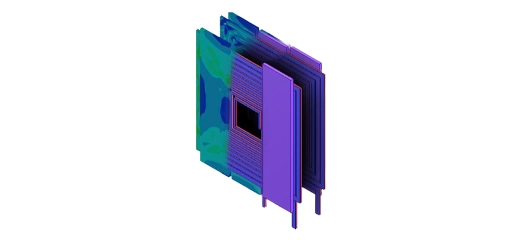Magnetostatic Analysis
Magnetostatic Analysis in EMWORKS?
- Magnetostatic analysis focuses on the study of static magnetic fields and their interactions with materials in equilibrium.
- Essential for understanding magnetic behaviors and optimizing designs in engineering and scientific applications.
- With built-in professional CAD and accessible simulation, EMWORKS simplifies the process of designing magnetic systems.
- Enables engineers to develop components such as magnetic materials, sensors, and electrical devices with greater precision and efficiency.
Key Features of EMWORKS Magnetostatic Analysis
Magnetostatic analysis, a critical component of electromagnetic simulation, empowers engineers and researchers to gain profound insights into magnetic fields and their impact on various systems and devices. Here, we unravel the key features and benefits that make magnetostatic analysis an indispensable tool in the realm of engineering and scientific exploration.
1. Precise Magnetic Field Modeling:
Magnetostatic analysis excels at accurately modeling magnetic fields in static conditions. It allows engineers to simulate and analyze the distribution of magnetic flux and field strength within devices and systems, providing a comprehensive view of how magnets and magnetic materials behave.
2. Magnetic Material Characterization:
Understanding the behavior of magnetic materials is essential in many applications, from designing efficient transformers to optimizing magnetic sensors. Magnetostatic analysis enables precise characterization of magnetic materials, including permeability, hysteresis, and saturation effects.
3. Magnetic Force Calculation:
Engineers can use magnetostatic analysis to calculate magnetic forces and torques within systems. This is crucial for designing electromagnetic devices such as motors, actuators, and solenoids, where precise control of forces is essential.
4. Coil and Magnetic Component Design:
Engineers can design and analyze coils, magnetic cores, and other magnetic components to optimize their performance. This is invaluable in applications such as electromagnetic actuators, transformers, and inductors.
5. Magnetic Shielding:
Magnetostatic analysis helps in designing effective magnetic shielding to protect sensitive equipment from external magnetic fields. It ensures that critical systems, such as medical devices or electronic circuits, remain unaffected by unwanted magnetic interference.
6. Magnetic Sensors and Detectors:
Magnetostatic analysis plays a crucial role in the development and optimization of magnetic sensors and detectors. Whether it's for measuring Earth's magnetic field or detecting anomalies in materials, accurate simulations are vital.
7. Magnetic Field Homogenization:
In applications requiring uniform magnetic fields, such as magnetic resonance imaging (MRI) machines or particle accelerators, magnetostatic analysis aids in designing field homogenization systems to achieve desired field strengths.
8. Material Selection and Optimization:
Engineers can use magnetostatic analysis to select the most suitable materials for magnetic applications and optimize their performance. This is vital for achieving desired magnetic characteristics while minimizing energy losses.
9. Energy Efficiency Improvement:
By optimizing the magnetic components and configurations in various devices, magnetostatic analysis contributes to enhanced energy efficiency in systems like power transformers, magnetic levitation trains, and renewable energy generators.
10. Safety and Compliance:
Ensuring compliance with safety standards and regulations, especially in industries where magnetic fields can impact human health, becomes more manageable with magnetostatic analysis. It aids in assessing potential risks and implementing necessary safeguards.
11. Research and Development:
Magnetostatic analysis is an indispensable tool in research and development across diverse fields. It enables scientists and engineers to explore new magnetic phenomena, develop novel technologies, and push the boundaries of what is possible in magnetism-related studies.
12. Cost Reduction:
By accurately predicting magnetic behaviors and optimizing designs through simulation, magnetostatic analysis helps reduce development costs and time-to-market for magnetic-based products and systems.
In summary, magnetostatic analysis offers a wealth of features and benefits that extend its utility across various industries and scientific disciplines. From precise modeling of magnetic fields to the design of magnetic components and ensuring safety and compliance, it is an invaluable tool for engineers, researchers, and innovators who seek to harness the power of magnetism in their endeavors.
Applications and Devices for Magnetostatic Analysis
Magnetostatic Analysis is a versatile tool that finds its applications in a wide range of devices and industries. Understanding the behavior of magnetic fields in static conditions is essential for enhancing the performance and efficiency of various systems. Here's a glimpse into the diverse set of applications and devices where Magnetostatic Analysis plays a pivotal role:
Electromagnetic Machines:
Magnetostatic Analysis is indispensable in the design and optimization of electromagnetic machines like generators, motors, and transformers. It ensures efficient power generation, distribution, and conversion.
Magnetic Shielding:
In applications where electromagnetic interference (EMI) needs to be minimized, such as sensitive electronic equipment and medical devices like MRI machines, Magnetostatic Analysis helps design effective magnetic shields.
Magnetic Levitation Systems:
For advanced transportation systems like magnetic levitation (Maglev) trains and magnetic bearings, understanding magnetic field behavior is crucial for stable and efficient operation.
Particle Accelerators:
In high-energy physics experiments conducted in particle accelerators, precise control of magnetic fields is essential. Magnetostatic Analysis aids in designing the magnetic components needed for these experiments.
Magnetic Resonance Imaging (MRI):
MRI machines rely on strong and stable magnetic fields. Magnetostatic Analysis is instrumental in ensuring the homogeneity and stability of these fields for accurate medical imaging.
Magnetic Sensors:
Devices such as Hall-effect sensors and magnetometers are used in various applications, including automotive systems, navigation, and robotics. Magnetostatic Analysis helps optimize their sensitivity and accuracy.
Magnetic Recording Media:
For data storage devices like hard drives and magnetic tapes, understanding magnetostatic behavior is crucial for ensuring data integrity and storage density.
Magnetic Couplers:
In applications where mechanical linkage is undesirable, such as rotary encoders and rotary transformers, magnetostatic couplers enable non-contact energy transfer and signal transmission.
Magnetic Particle Inspection (MPI):
In non-destructive testing of materials for defects or cracks, MPI uses magnetic fields to reveal imperfections. Magnetostatic Analysis assists in optimizing the inspection process.
Magnetic Separation:
Industries like mining and recycling use magnetic separation to extract valuable materials from ore or separate recyclable materials. Magnetostatic Analysis helps design efficient separation systems.
Magnetic Valve Actuators:
In applications like automotive engine control and industrial automation, magnetostatic actuators are used for precise control. Analysis ensures their reliable performance.
Magnetic Couplings:
In pumps and other rotating equipment, magnetic couplings eliminate the need for seals, reducing the risk of leakage. Magnetostatic Analysis helps optimize their torque transfer capabilities.
Geomagnetic Sensors:
Devices that measure Earth's magnetic field, like compasses and magnetometers, rely on accurate magnetostatic behavior analysis for precise navigation and orientation.
Electromagnetic Compatibility (EMC):
Ensuring electronic devices do not interfere with each other or are immune to external interference is crucial. Magnetostatic Analysis helps design EMC solutions.
Wireless Charging:
In wireless charging systems for electric vehicles, consumer electronics, and medical devices, magnetostatic analysis helps optimize the magnetic field for efficient energy transfer.
Railway Signaling:
Magnetic sensors and actuators are used in railway signaling systems for accurate train detection and control. Magnetostatic Analysis ensures their reliability.
Induction Heating:
In industrial applications like metal hardening and cooking appliances, induction heating relies on magnetostatic principles. Analysis optimizes heating efficiency.
Magnetic Fluids:
Magnetostatic Analysis aids in the development of magnetic fluids used in applications like damping, sealing, and medical diagnostics.
Research and Development:
Magnetostatic Analysis is an invaluable tool in research across various fields, including material science, geophysics, and astrophysics.
Energy Generation:
In renewable energy applications like wind turbines and hydroelectric generators, magnetostatic analysis optimizes the performance of magnetic components.
Electromagnetic Locks:
Security systems often use electromagnetic locks that rely on magnetostatic principles to provide secure locking mechanisms for doors and gates.
Magnetic Particle Imaging (MPI):
In the field of medical imaging, MPI is an emerging technique that uses magnetostatic analysis to produce high-resolution images of the body's internal structures.
Marine Navigation:
Magnetostatic compasses are essential for navigation at sea, helping ships and boats determine their heading even in the absence of GPS signals.
Magnetic Bearings:
Advanced machinery, such as high-speed rotating equipment and flywheels, utilizes magnetic bearings for frictionless operation and precise control.
Magnetic Separators in Food Processing:
In the food industry, magnetic separators remove unwanted ferrous contaminants from food products, ensuring food safety.
Geomagnetic Surveys:
In geology and mineral exploration, magnetostatic surveys are conducted to map subsurface geological structures and identify valuable mineral deposits.
Magnetic Particle Brakes and Clutches:
These devices are used in industrial machinery to control torque and motion. Magnetostatic analysis helps optimize their performance.
Magnetic Therapy:
In healthcare, magnets are used for pain relief and rehabilitation. Magnetostatic analysis contributes to the design of effective therapeutic devices.
Magnetic Locking Systems:
High-security facilities employ magnetostatic locks that require accurate analysis for reliability and tamper resistance.
Marine Propulsion:
Electric propulsion systems in marine vessels, such as ferries and research vessels, rely on magnetostatic analysis to enhance energy efficiency.
Magnetostatic Analysis plays a pivotal role in these diverse applications, ensuring the efficient and reliable operation of numerous systems across various industries.
Results of EMWORKS Magnetostatic Analysis
The Magnetostatic module outputs the following results for each study:
- Magnetic field
- Magnetic flux density
- Current density
- Force density
- Inductance matrix
- Flux linkage
- Induced Voltage
- Back EMF
- Resistance
- Force
- Torque
- Stored energy
- Temperature
- Temperature gradient
- Heat flux
These comprehensive results allow engineers and researchers to gain a deep understanding of magnetic field behavior, optimize designs, and ensure the efficient and safe operation of devices and systems in various fields, from electronics and manufacturing to healthcare and transportation.



